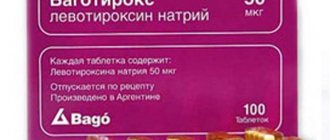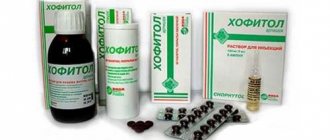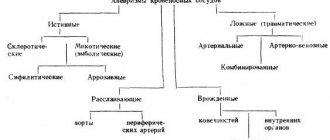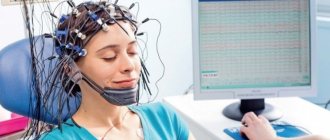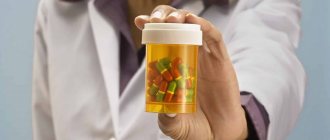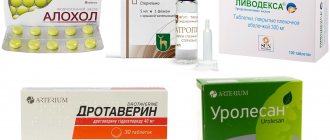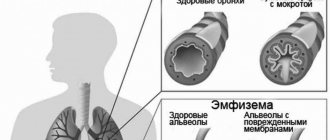The brain is the most sensitive organ to oxygen starvation. Therefore, when blood flow is disrupted, significant cell damage occurs, which manifests itself in the form of headaches, dizziness, memory loss and impaired coordination of movements.
Drugs for the treatment of cerebral circulatory insufficiency dilate blood vessels, improve the nutrition of neurons, facilitate the movement of blood, giving it fluidity. All this allows you to fully or partially restore brain functions.
The main causes of pathology and stages of its development
Near the spine, blood vessels, rich in oxygen and nutrients, pass from the heart to the brain. The lateral processes of the vertebrae form a canal through which the vertebral arteries pass, the function of which is to supply blood to the occipital, temporal lobes and inner ear. These areas of the brain are responsible for the perception and processing of visual and sound information, as well as for the analysis of taste and smell. The center of balance is in the inner ear.
Note! A pathological change in the vertebrae can be called a situation when they slightly change their position, therefore, the channels narrow, which leads to disruption of blood flow and a sense of balance. However, osteophytes, the same bone growths, irritate nerve endings and blood vessels and provoke their spasms. This is the essence of osteochondrosis.
There are three stages of pathological changes in blood circulation in osteochondrosis of the cervical spine.
- At the first (initial) stage, the patient experiences dizziness, headache spasms, ringing and noise in the ears, problems sleeping, decreased productivity and focusing on anything.
- In the second stage (subcompensation), the patient is characterized by forgetfulness, lethargy, problems with controlling his actions and speech, and his mental and physical activity is noticeably reduced.
- During the third stage (decompensation), the patient’s central nervous system experiences irreversible changes that make the person conditionally incapacitated, that is, from that moment on, he is unable to independently care for himself and his life.
There are several stages of development of cervical osteochondrosis
Eating disorders and the development of ischemic changes can provoke the occurrence of symptoms that are typical for the symptoms of osteochondrosis of the neck. A person begins to feel pain in various parts of the head, tinnitus, and also complain of problems with vision and hearing. There is the most severe manifestation of this disease, the symptoms of which are similar to those of ischemic stroke.
If negative influencing factors are periodically repeated, then even many years of remission will not be able to protect against the return of the diagnosis.
The most common reasons will be presented below, but this does not mean that there are others. Most residents of large cities are at risk of developing this disease or are already taking special medications for cervical osteochondrosis.
- Overeating and, as a consequence, excess weight, since there is no disease that would not be complicated by the presence of excess fat.
- Problems with posture.
- Constant and long-term work at the computer.
- A sedentary or lying lifestyle is one of the main factors. If a person does not move enough, then his muscles weaken due to “uselessness”. They usually take on most of the load on the spine. But in a weakened state of the muscles, the spine will not be able to cope with heavy loads for long.
In order to prevent and prevent further development of the disease, it is customary to prescribe treatment with vasodilating drugs.
Also, doctors specializing in psychosomatics identify slightly different reasons for the development of cervical osteochondrosis. Let's look at them in the table below.
| Vertebra number | Causes |
| C1 | Fear. Confusion. Escapism. Dissatisfaction with yourself. “What will people say?” |
| C2 | Denial of wisdom. Refusal to know and understand. Indecisiveness. Resentment and accusation. Unbalanced relationship with life. Denial of spirituality. |
| C3 | Accepting the blame of others. Guilt. Martyrdom. Indecisiveness. Self-exhaustion. You bite off more than you can chew. |
| C4 | Guilt. Suppressed anger. Bitterness. Repressed feelings. Barely restrained tears. |
| C5 | Fear of ridicule and humiliation. Fear of expressing yourself. Denial of one's own good. Overload. |
| C6 | Heaviness. Overload. The desire to correct others. Resistance. Lack of flexibility. |
| C7 | Confusion. Anger. Feeling helpless. Inability to reach. |
| Neck pain is always caused by insufficient flexibility and strength of will. When a person is doing well, he can easily turn his neck, turn his head to the left, right, and look sharply down or up. This does not cause him any difficulties. But if his neck hurts, then it is not so easy for him to change his point of view, both literally and figuratively. A person seems to “rust” - both externally and internally. And osteochondrosis of the cervical spine appears when he forbids himself to agree or, on the contrary, to refuse, but still continues to do so due to some circumstances. | |
| Osteochondrosis itself is an unnatural position of any part of the spine, that is, the basis of the whole organism. Probably, a patient with osteochondrosis has a hard time tolerating what is given to him at the moment. For example, he needs to agree to a dishonest act for his own good. And if he continues to do wrong, despite internal prohibitions, sooner or later his neck will hurt. | |
When are vasodilators needed?
Poor cerebral circulation initially manifests itself as symptoms of fatigue. A person does not get enough sleep, feels constantly tired, and loses interest in life. However, if this condition does not go away for a long time, you should consult a doctor. Ignoring the first signs of cerebrovascular pathology leads to its progression and the development of complications. Soon you may experience:
- chronic headaches, sometimes with dizziness and loss of consciousness;
- problems with memory, concentration, and decreased performance;
- numbness of the arms and legs, loss of coordination and function of the lower extremities (intermittent claudication);
- insomnia or, conversely, increased drowsiness;
- behavioral and mental disorders.
The listed symptoms develop against the background of chronic oxygen starvation of brain tissue and lack of nutrients. Ischemia gradually leads to the death of areas of the medulla with irreversible consequences. Due to the narrowing of the arteries of the head, the blood pressure in them increases, which often leads to rupture of the vascular wall - hemorrhagic stroke. Its consequences are disability or death.
Who necessarily needs to take vascular drugs for the brain? First of all, people with diagnosed heart and vascular diseases - arterial hypertension, atherosclerosis, migraine. For diabetes mellitus, vasodilator medications are also indicated, since this pathology in most cases is accompanied by the formation of atherosclerotic plaques, blood clots, and increased blood pressure. Neurological disorders in children caused by birth injuries also often cause spasms of the arteries of the head.
Mechanism of action
Medications specializing in vasodilation and used in the treatment of neck osteochondrosis are divided into 2 general groups.
- Centrally acting drugs that act on the vasomotor center, which, in turn, is located deep inside the brain.
- Peripheral-acting drugs, which are divided into a couple of subgroups:
- drugs that are used to weaken the pain nerve impulse. They belong to the group of neutropic principles of action: they block the impulse, thereby stopping its harmful effect on smooth vascular muscles and preventing spasms;
- drugs that are used to directly or indirectly influence the vascular muscles, thereby helping to increase the lumen of the vessel. The need for this therapy is that it helps to cope with spasms of the smooth muscle walls that regulate the lumen of blood vessels. The lumen of the blood vessels should not narrow, as this makes it difficult to nourish the tissues.
You only need to contact a specialist to select the right medicine - based on the tests, he will prescribe the right drug
Only a doctor who specializes in this is able to correctly draw up a treatment plan and select a set of medications that will help cope with this pathology. It is important to note that taking these medications cannot be long-term. When the natural course of transmission of nerve signals to the blood vessels is normalized, their reception can be completed. If you follow the doctor’s treatment plan, you can avoid unwanted severe consequences and complications for your body and health when treating cervical osteochondrosis with various drugs.
Vessel cleaning preparations
Most often, cleaning blood vessels means lowering cholesterol levels in the blood. Many patients prefer to use folk remedies, but modern pharmacology can offer quite effective means for stabilizing cholesterol and gently cleansing the vascular system of the body.
Preparations for cleaning the circulatory system are divided into several groups:
- Medicines whose action is aimed at reducing the synthesis of low-density lipoproteins.
- Drugs that prevent excess fat from being absorbed from the intestinal lumen.
- Means for regulating the production of high-density lipids.
- Vitamin complexes.
In maintaining health, including the vascular system, proper nutrition plays an important role, in which the consumption of heavy fats is eliminated as much as possible. A lot of greens and vegetables, clean water are added to the patient’s menu, the patient needs to walk every day and maintain muscle tone.
Preparations based on natural extracts
Medicines based on extracts of medicinal herbs are used to prevent pathologies with insufficient blood supply to the brain. Such products allow you to gently cleanse the entire vascular system of harmful deposits and help improve blood circulation.
Preparations with the following active ingredients are used:
- sand immortelle;
- motherwort;
- hawthorn;
- pollen;
- rose hip.
Dietary supplements help reduce blood clots and improve metabolic processes at the cellular level, saturating cells with oxygen. Natural additives to the complex therapy of circulatory disorders reduce the absorption of cholesterol into the blood, increase the elasticity of blood vessels and stabilize the functioning of the heart.
For preventive purposes, dietary supplements are used to reduce blood clotting and can be used during the postoperative recovery period. Since such drugs are not medicines, they have no contraindications other than allergic reactions.
The use of drugs based on natural extracts should be carried out under the supervision of a specialist; self-medication is strictly prohibited.
About precaution
Do not overuse vasodilators.
Note! You cannot take all drugs of this effect at once. Making a treatment plan on your own can be very risky and dangerous. It is the treating specialist, and not someone else, who must analyze the symptoms, make a diagnosis, and then prescribe the necessary medications.
Every doctor has his own opinion about vasodilator drugs. This may be due to the fact that any small error can cause harm to a person, so it is important to know that such medications:
- provoke the removal of calcium from the body, which can have a negative effect on the restoration of bones and intervertebral discs;
- act not only on affected vessels, but also on healthy ones, and this leads to the opposite effect;
- often lead to a “stealing effect”, i.e. they dilate and improve the condition of healthy blood vessels, and not those for which the therapy was carried out.
Vasodilators have some contraindications and side effects
It is clear that vasodilation as the main treatment for ischemia and atherosclerosis cannot be considered a good option.
Like any medicine, drugs for vasodilation have certain contraindications. Some of them are like this.
- Pregnancy and breastfeeding.
- Epilepsy.
- Cardiac disorders.
- Hypertension, that is, constant high blood pressure.
- Kidney failure.
You should also stop taking medications if you have allergies or individual intolerances.
The connection between osteochondrosis and the brain
Cervical osteochondrosis has a negative effect on the blood vessels of the brain. When there is a disease of the spine, pathological changes occur in the intervertebral discs. Lack of nutrition leads to their degeneration, a decrease in the distance between the vertebral bodies, and friction. In response to mechanical irritation, growths (osteophytes) form along the bone edges, which compress the arteries and nerve tissue. Vascular disorders provoke poor blood circulation and insufficient oxygen delivery to the brain, causing ischemia.
Constant irritation of nearby muscle tissue causes inflammation and spasms, increasing compression on blood vessels and nerve endings. Spinal deformation leads to a narrowing of the spinal canal, causing neurological disorders.
Against the background of cervical osteochondrosis, neurovascular syndrome develops, which occurs when the vertebral artery is compressed and is characterized by the following symptoms:
- Throbbing pain radiating to the temporal zone, eye area, lower jaw. Headaches appear on one side and are paroxysmal in nature.
- Noise hallucinations in the head and ears. Vestibular disorders occur, which affect coordination of movements, dizziness with cervical osteochondrosis.
- Visual disturbances, fog and spots before the eyes.
- Increased blood pressure, increased heart rate, hand tremors, nausea. Cervical osteochondrosis and hypertension become inseparable companions.
- Neurological disorders. A person experiences speech hesitations and the pronunciation of some letters becomes smoother.
On a note. Narrowing of the vessels of the cervical spine can lead to acute circulatory problems in the brain center and stroke.
List of special substances for vessels
Vascular medications for osteochondrosis of the cervical spine are prescribed by a doctor. Various drugs are used to normalize blood flow.
Aminophylline (“Eufillin”)
Today, one of the most well-known active ingredients of vasodilator drugs is aminophylline. An example of such a medicine is “Eufillin”. It is usually prescribed as tablets, but there is also a type of medicine for intramuscular and intravenous therapies. It is also widely used with electrophoresis for pathological processes in the spine. The main function is based on the fact that it relaxes vascular smooth muscles, so taking this drug helps prevent the development of blood clots and improve circulation. Ultimately, the pain is relieved and blood circulation improves as the muscles relax.
You should only take this medication if it has been prescribed by a specialist, because it has several unpleasant side effects. For example, convulsive syndrome, pain in the heart, blood pressure may suddenly drop, dizziness and some others.
Rules for taking Eufillin
Nicotinic acid, or vitamin PP
Nicotinic acid is used to dilate small vessels, even those in the brain. The use of this drug has a good effect on blood circulation, allows you to achieve a special effect and lowers the cholesterol level in the blood. Basically, the substance is used intramuscularly, but there are cases when it is administered intravenously.
Side effects of vitamin PP include dizziness, slight redness of the face, flushing of the upper body, and a feeling of flushing in the head. There is no need to worry if this medicine has been prescribed, since all the “side effects” listed above are short-lived, which means they will quickly disappear.
Rules for taking nicotinic acid
Lipoic acid, or berlithione
Lipoic acid is used in medicine to improve endoneurial blood flow. Berlition stimulates the strengthening of blood vessels and leads to cell restoration.
In tablets, take 0.05 g after meals 3-4 times a day.
Pentoxifylline
Pentoxifylline helps get rid of spasms in blood vessels and has a good effect on clotting. Also, the use of this drug has the following effect: it stops platelet aggregation and makes the blood less viscous, which leads to increased bleeding in problem areas.
The drug is used both intravenously and in tablets. Bad consequences include hypotension, arrhythmia, heart pain, and headaches.
Rules for taking pentoxifylline
"Trental"
Experts often prescribe Trental, which is based on pentoxifylline. It is used to improve blood circulation in damaged areas of the spine, and it is also able to improve fibrinolysis and reduce blood viscosity, which is followed by improvements in the movement of oxygen and essential nutrients to the tissues of the spine. Trental is taken either in ampoules or tablets.
Rules for taking Trental
"Mexidol"
This drug is necessary for the regeneration of red blood cells and platelets, as well as for vasodilation. Mexidol helps blood flow to the brain.
Take 125–250 mg 3 times a day.
Cinnarizine
For osteochondrosis of the neck, cinnarizine is an excellent medicine. It is part of the drug "Stugeron". This drug has a decisive effect on the vascular walls, which provokes an increase in their lumen. In this regard, blood flow is regenerated, the blood becomes less viscous, and dizziness also disappears. Cinnarizine does not particularly affect the heart and blood pressure - this is its exceptional quality, and it is also easily tolerated. Negative effects after taking can only be dry mouth and dyspeptic symptoms. Available only in tablets.
Rules for taking cinnarizine
"Actovegin"
Actovegin is a truly powerful medicine. This drug improves the tone of the blood flow system and activates metabolism in any tissue. The main and main actions of Actovegin occur in pathological places.
The drug is taken before meals, 2-4 tablets per day.
Vinpocetine
Vinpocetine is a popular medication, also called Cavinton.
Cavinton is often prescribed for the treatment of cervical osteochondrosis, as it helps reduce vascular tone without affecting blood pressure and the heart. The peculiarity of the medicine is that it improves blood circulation only in those areas of the brain where there are any deviations from the norm.
Another important feature of vinpocetine is the regeneration of the rheological properties of blood: the blood becomes less viscous, and the tendency of platelets to aggregate is minimized. At the same time, this drug has a positive effect on red blood cells. It also stimulates metabolism in the brain and increases resistance to hypoxia.
Cavinton is used both intravenously and in tablet form. Side effects are very rare. If they do manifest themselves, then in the following way: pressure fluctuations, dizziness, headaches.
Rules for taking Cavinton
Piracetam
Piracetam can be called the most effective remedy for this diagnosis than others written above. It is included in such drugs as Nootropil and Lucetam. These medications are classified as nootropic medications.
Piracetam improves intellectual functions, regenerates circulation, and also activates blood flow in blood vessels. This regenerates blood flow in damaged areas of the brain.
Piracetam is mainly used for intramuscular and intravenous therapy. This medicine also exists in both capsule and tablet form. The dosage and treatment method are chosen by the attending physician-specialist.
Rules for taking Nootropil
"Omaron"
In some individual situations, treating specialists prescribe combination drugs for the treatment of neck osteochondrosis, which makes it possible to reduce the number of medicinal pills without changing the results of treatment. In this case, the simultaneous use of cinnarizine and piracetam may be prescribed. For example, the medications “Omaron” and “Fezam”, which are available in capsule form, are suitable.
Rules for taking "Omaron"
What are vasodilator drugs?
Any disturbances in blood flow require treatment, since prolonged oxygen starvation with spasms of cerebral vessels leads to dementia and multiple disorders in the functioning of the body. Pharmacological developments offer a wide selection of drugs that improve blood counts and cleanse the bloodstream from the accumulation of plaques.
There are also various vasodilators, the action of which is aimed at improving blood flow and fully supplying tissues with all nutrients.
Treatment of any blood flow pathologies depends on the cause of their occurrence, so there are several types of drugs for therapy:
- Statins. The action of the active component is aimed at reducing cholesterol levels in the blood, destroying atherosclerotic plaques, and cleansing the lumen of the bloodstream. The most commonly used drugs are lovastatins and simvastatins (Mevacor, Vasilip, Actalipid).
- Fibrates. The active substance acts against high cholesterol, but this type of medication is not combined with statins and is prescribed for the treatment of atherosclerosis. Popular agents are Atromid, Clofibrate, etc.
- Antispasmodics. This series of drugs is aimed at relieving vascular spasm (caused, for example, by simultaneous intake of alcohol and smoking), and is effective in treating pathologies of blood supply in cervical osteochondrosis.
- Vasodilators. Improves the quality of blood flow by dilating the vessel. These include Papaverine hydrochloride, Cavinton, Actovegin, etc.
To treat pathologies of brain nutrition caused by surges in blood pressure, complex treatment with the use of vasodilators (vasodilators) is used. They relax and expand the lumen of the arteries, reducing pressure and restoring proper nutrition.
Treatment of neck osteochondrosis with ointments
When treating osteochondrosis, special ointments are often used to alleviate the patient’s illness. Their peculiarity is that they have a very small number of contraindications (possible pressure changes, headaches, nausea, dizziness and drowsiness), act gently and do not cause discomfort. Abiflor ointment is very effective and popular among people, which helps to expand and strengthen vascular walls, as well as regenerate their patency and reduce pain. The composition includes the following components: perfume oils, emulsifiers, fir water extract, vitamin E and some others.
At the same time, there are other ointments with the effect of dilating the walls of blood vessels, which have a warming effect:
- "Nicoflex";
- "Menovazan";
- "Gevkamen" and others.
The use of vasodilating ointments gives no less effective results
The main thing to remember is that before taking vascular medications, be they tablets, ointments, or drugs for intravenous or intramuscular administration, you must consult with a qualified medical specialist in the field. You can see different reviews about the above medications, and thanks to them and a specialist, it is possible to choose the very “panacea” that will free a person from unpleasant symptoms.
Injections to dilate blood vessels
Vasodilator injections can quickly relieve symptoms of lack of blood circulation in the brain and prevent the risk of developing other diseases. Thanks to injections, drugs are quickly absorbed into the blood, affecting blood vessels.
Medicines used:
- Derivatives of the vinca alkaloid help relieve vascular spasms and lead to their dilation. They have a beneficial effect on metabolic processes and prevent platelet aggregation. The course of injections and the administration schedule are selected only by the attending physician.
- Injections based on nicotinic acid. Dilate small vessels and capillaries, reduce blood sugar. Dispensed by prescription. The doctor can choose the following drugs: Nicospan, Enduracin, Nicotinic acid.
- Eufillin. Available in the form of injections and tablets. Dilates the bronchi, improves ventilation of the alveoli, relieves smooth muscle spasms, and promotes active blood circulation.
- Actovegin increases the glucose content in the cell, activates its energy supply, accelerates the process of blood supply and wound healing. Prescribed for vascular and cerebral disorders.
The course of injections should be prescribed only by the attending physician - it is safe and will bring maximum benefit in the recovery process.
Prevention of osteochondrosis
Prevention of various diseases always takes place in the life of any person, and osteochondrosis is no exception. To do this, it is enough to try to adhere to a healthy lifestyle, do gymnastics and be in physical shape. Stress and other emotional shocks can give a good start to the development of osteochondrosis, so it is necessary to avoid stressful situations or cope with them without breaking points. Proper nutrition is a truly important part of the prevention and treatment of neck osteochondrosis.
Contraindications to taking medications
Vasodilator drugs have some contraindications. It is strictly prohibited for people with low blood pressure to take drugs that improve cerebral circulation in case of cervical osteochondrosis. Vasodilation will lead to an even greater decrease in blood pressure.
Not all tablets are suitable
Also contraindications are:
- myocardial infarction less than a year ago;
- low level of platelets in the blood - poor blood clotting;
- allergies in aggravation;
- hemorrhagic stroke;
- intolerance to the components of the drug;
- kidney problems;
- acute arrhythmia;
- cardiac ischemia.
People with epilepsy, as well as those in a pre-infarction state, should not take medications of this effect.
Even with clear indications for taking drugs in this group, you should not self-medicate: this can significantly worsen the functioning of the cardiovascular system.
Osteochondrosis - clinics in
Choose among the best clinics based on reviews and the best price and make an appointment
Family
Oriental Medicine Clinic "Sagan Dali"
Moscow, prosp.
Mira, 79, building 1 Rizhskaya
+7
- Consultation from 1500
- Diagnostics from 0
- Reflexology from 1000
0 Write your review
Family
Back and joint treatment clinic No. 1
Moscow, Pyatnitskoye sh., 6, bldg.
1 VolokolamskayaMitino
+7
- Consultation from 1000
- Treatment courses from 7000
- Massage from 1500
10 Write your review
Family
Institute of Traditional Oriental Medicine
Moscow, Filippovsky lane, 18
Arbatskaya (FL)
8-(495) 691-66-69
registry
- Consultation from 1200
- Manual therapy from 1300
- Physiotherapy from 700
0 Write your review
Show all Moscow clinics
The main causes of the development of cervical osteochondrosis
Various reasons can provoke the development of osteochondrosis of the cervical spine. Usually this is a passive lifestyle, sedentary work, injury, an uncomfortable place to rest and sleep. People who frequently drink alcohol and are overweight can also get sick. A hereditary factor can also sometimes cause pathology.
Just 10 years ago, cervical osteochondrosis was considered an ailment of elderly and mature people, but today the disease has become significantly “younger”. The diagnosis is now given to girls and boys aged 20-25 years, or even younger. This is affected by the sedentary lifestyle of modern people. Other reasons that can lead to the development of the disease:
- excess weight – creates additional stress on the spine;
- forced uncomfortable postures when performing everyday work;
- hypothermia of the cervical spine;
- autoimmune diseases that provoke cartilage degeneration;
- problems with posture, flat feet, scoliosis, rheumatism;
- stress, constant nervous tension;
- deficiency of calcium, silicon, sulfur and amino acids in food;
- osteoporosis – destruction of bones due to the loss of a large volume of mineral elements;
- endocrine pathologies.
Osteochondrosis - specialists in Moscow
Choose among the best specialists based on reviews and the best price and make an appointment
Massage therapist
Zakrevskaya Natalya Alekseevna
Moscow, 1st Lyusinovsky Lane, 3 B. (Medical) +7
0 Write your review
Masseur
Avtandilyan Arsen Alikovich
Moscow, Landyshevaya st., 14, bldg. 1 (Medical)
+7
0 Write your review
Masseur
Manifestations of vascular spasms in neck osteochondrosis
Due to osteochondrosis in the cervical sector of the spine, pinched nerve roots may develop, as well as narrowing of blood vessels. Treatment of such a phenomenon must be prompt and comprehensive, since the pathology can lead to blood obstruction and, as a result, death.
The symptoms of the pathological condition are vivid, and it is impossible not to pay attention to them. Patients complain to the doctor of pain in the neck - shooting or throbbing, pulling or stabbing. The sensations can be either very weak or intense, appear both constantly and episodically. The pain is localized in the back of the head and neck, radiates to the shoulder girdle and arms, and becomes more noticeable when bending and turning the head.
Pinching of the cervical nerves due to osteochondrosis can cause impulses along the motor, autonomic and sensory fibers. The patient begins to feel, to one degree or another, numbness, burning, tingling, “goosebumps” in different parts of the body, decreased sensitivity of the skin, general fatigue and muscle weakness. The skin tone in the affected area often changes.
Side effects
The use of vasodilator drugs for the head must be approached with the utmost seriousness. Like other medications, they have their side effects and may have contraindications. This also applies to exceeding the recommended dosage.
Attention! It is recommended to use drugs of this type only after consulting your doctor, as using them for other purposes can lead to dangerous consequences.
Patients are often confident that vasodilator medications are exclusively positive and cannot in any way harm a healthy body. This is not true, especially if, among other things, the patient suffers from sclerotic plaques or has blood clots in the vessels. In this case, the medicine will only expand the healthy wall of the vessel, while the damaged one will remain intact. Then, after use, a sharp deterioration in well-being is possible. The same applies to long-term use of vasodilator drugs. They are capable of:
- Cause addiction, increase the body's tolerance to medications of this type.
- Provoke bleeding.
- Cause dizziness.
- Cause a pre-fainting state.
- Promote the occurrence of allergic reactions.
- Increase fatigue.
- Cause the development of kidney and liver diseases.
Taking into account this information, it is recommended to refuse any self-medication and be sure to consult a specialist. Otherwise, there is a considerable risk of significantly worsening your health even after just a few uses.
Indications and contraindications
Vascular medications for osteochondrosis normalize blood supply to the painful area and brain tissue. They must be prescribed to patients in the following cases:
- encephalopathy;
- vasospasm;
- cervicalgia;
- tendency to thrombosis;
- cervical radicular syndrome;
- increased blood viscosity.
Contraindications are:
- diabetes;
- severe arrhythmias;
- individual intolerance;
- coronary sclerosis;
- pregnancy and breastfeeding.
Causes of vasoconstriction
There are cases when problems with blood vessels in humans are genetically determined.
But in most situations, vascular pathologies are a consequence of lifestyle. Heavy mental stress, poor environmental situation and stress, hereditary diseases are important factors that provoke loss of elasticity and premature wear of capillaries. Migraine, dizziness, memory loss and rapid fatigue are the first signs of vascular diseases.
Atherosclerosis. Accompanied by insomnia, depressed state and prolonged depression, deterioration of vision, hearing and memory, and frequent dizziness. It is characterized by a narrowing of the volume of the lumen of the blood flow with its subsequent blockage due to the proliferation of connective tissue, the appearance of cholesterol plaques and excessive deposition of calcium salts.
Cerebral vasospasm. The source of insufficient blood microcirculation is vascular dystonia, smoking, overwork, old age, osteochondrosis, hypertension and heart disease. People with this diagnosis experience fainting, slurred speech, and loss of motor activity.
Cerebrovascular accident. Accompanied by a decrease in visual and hearing acuity, seizures, deterioration in thinking, partial temporary paralysis, loss of reading, writing, and speech skills. Causes: plaques, blood clots, blood pressure surges, cervical osteochondrosis and head injuries.
Ischemia. Oxygen saturation of cells is hampered by diabetes, poor nutrition, anemia, kidney disease and tumors, and obesity. Signs of damage to the meninges include loss of concentration, outbursts of aggression, a shuffling gait and urinary incontinence.
Stroke. Congenital pathologies or atherosclerosis, heavy physical activity and arterial hypertension cause destruction of vascular walls, followed by hemorrhage, necrosis of tissue areas, and cell death.
Ointments: doctors' recommendations
- Abiflor - cream-gel based on Siberian fir strengthens blood vessels, relieves swelling and pain.
- Larkspur is a warming ointment that relieves minor pain in the neck.
- Virapil, Apizartron based on snake or bee venom, camphor and fir oil create a quick warming effect.
- Dolobene – ointment relieves swelling and increases metabolism.
- Voltaren emulgel quickly relieves inflammation and improves blood circulation.
- Chondroitin is a mild chondroprotector ointment.
Medicinal ointments
Drugs of this kind are usually prescribed during remission of the disease. Ointments and compresses have a minimum of contraindications and are used exclusively for external use. They act very gently, without causing discomfort to the body. The effectiveness of such products is determined by the concentration of active substances and their type.
The action of Abiflor ointment is aimed at expanding and strengthening the walls of blood vessels, increasing their elasticity, as well as relieving pain and restoring vascular patency. The product activates capillary blood circulation, which helps accelerate the recovery of affected areas, enriches blood vessels and tissues in which degrading processes are significantly slowed down.
Also, ointments have a good warming effect and vasodilating effect: Menovazan, Gevkamen, Nicoflex and others.
Due to the fact that the skin can absorb approximately 7–10 percent of active ingredients, ointments have a milder effect on the affected area and the body. In most cases, drugs are prescribed during the period of remission of the disease, have a minimum of contraindications, act gently and without stressful situations for the body. Efficiency is determined by the type and concentration of the active substance.
Abiflor
Abiflor
It is made from an aqueous extract of Siberian fir and contains lipoderm, katon, tocopherol, perfume oil and a complex of biologically active substances. Expands and strengthens the walls of blood vessels, increases their elasticity and minimizes the risk of fragility. When painful spasms of vascular muscles occur, the ointment relieves the consequences and restores their patency.
Apply to the sore spot with light circular rubbing movements; the duration of the full course of treatment is selected depending on the complexity and stage of the disease and ranges from one to three weeks.
Applying cream to the cervical spine
The ointment is subject to preliminary certification for the possibility of allergic reactions of the body.
Most warming ointments used during the treatment of neck osteochondrosis, in addition to the main effect, have an additional vasodilating effect. The use of ointments allows you to consolidate the positive results obtained with medications. Ointments made on the basis of camphor, eucalyptus oil, menthol and capsaicin (Gevkamen, Nicoflex, Menovazan, etc.) show a good effect.
Gevkamen ointment tube 30 g
Nicoflex
Menovazan ointment
Migraine treatment
Migraines are characterized by attacks in which the functioning of the circulatory system is disrupted. But the patient's condition is slightly different.
Stages of the disease:
- Violations of vascular tone.
- Vascular spasm.
- Vasodilation is noted against the background of decreased tone.
- Swelling of blood vessels and adjacent tissues is characteristic.
- Return to original condition.
In this case, vasodilator therapy will not be suitable. The patient is prescribed analgesics along with non-steroidal anti-inflammatory drugs.
How to use
Depending on the purpose of treatment, drugs can be used both for one-time use and for complex therapy. Each of the medications described above has both its own indications and contraindications for use.
To avoid any complications, it is recommended not only to carefully read the instructions, but also to consult with your doctor. It is highly recommended not to approach the use of drugs that dilate blood vessels in the brain thoughtlessly and self-medicate. Otherwise, this can lead to a number of serious complications.
To achieve the fastest possible therapeutic effect, it is recommended to use injections. Drugs for complex treatment must be used together with glucose solution or other excipients.
Preventive measures
Prevention of neck osteochondrosis consists of moderate physical activity, regular warm-up, careful treatment of the spine and proper nutrition. It is recommended to eat more vegetables, replace unhealthy sweets with fruits, and give up bad habits. It is worthwhile to periodically engage in self-massage of the neck, this is especially important for office workers who spend a lot of time in a static, awkward position when working with a computer.
Exercises to improve cerebral circulation
Special physical exercises have a good preventive and therapeutic effect. By performing them regularly, you can strengthen your muscle corset and improve blood circulation. A set of home activities can include the following:
- Sitting on a chair with a straight back, turn your head to the left and then to the right. Next, tilt your straight head back and forth.
- Lie on the floor with your stomach down. Turn your head left and right, reaching the floor with your ears alternately.
- Place your hands on your forehead and bend your head forward, resisting the movements of your hands.
- Stand up straight, lower your head down as much as possible so that your chin touches your chest.
An approximate set of physical exercises for cervical osteochondrosis, which can be performed at home, is presented in the video.
Pentoxifylline
The drug is available in the form of tablets and solution for injection. Designed to improve blood microcirculation. The active substances of the drug increase the elasticity of red blood cells, destroy blood clots, reduce blood viscosity, and saturate it with oxygen. The product dilates blood vessels, improves the activity of the central nervous system, and normalizes blood microcirculation in problem areas.
Instructions for use of Pentoxifylline
At home, use the tablet form of the medicine. Drink after meals, with a small amount of liquid. Single dose - 2 tablets. In case of exacerbation of osteochondrosis, take the medicine three times a day. The course of treatment is long, at least 4 weeks. After 2 weeks, reduce the single dose to 1 tablet.
Anticoagulants and antiplatelet agents
Drugs of the presented groups are prescribed to reduce blood viscosity and improve its fluidity. This increases blood supply to brain tissue and oxygenation of neurons.
Antiplatelet agents and anticoagulants effectively help get rid of transient ischemic attacks, reduce the risk of ischemic stroke, and prevent the formation of blood clots and emboli.
The presented medications that improve cerebral circulation by thinning the blood are used only after passing all laboratory tests, as well as studying data on possible contraindications.
When using these products, it is necessary to periodically donate blood to study the coagulogram and biochemical properties.
The most common anticoagulants include: Warfarin, Fraxiparine, Clexane, Fragmin.
Representatives of antiplatelet agents are: Aspirin, Curantil, Pentoxifylline, Ticlopidine.
If suspicious bluish spots appear on the skin or visible mucous membranes, as well as increased bleeding from the nose, black feces or vomiting blood, you should immediately consult your doctor.
Preparations for strengthening the walls of veins and arteries
The functioning of all organs, including the brain, depends on the normal functioning of the blood system. They supply them with blood, which contains oxygen, nutrients and vitamins.
Vascular strengthening tablets make blood vessels elastic and have good permeability.
- It is worth highlighting vitamins PP and C. These substances of natural origin help improve elasticity and prevent vascular fragility. To improve the condition of cerebral vessels, you need to eat dark-colored berries or use dietary supplements based on them, for example, Blueberry Forte. Ascorutin is the most common drug of the first group.
- Important microelements such as selenium, silicon and potassium. They are found in food, but if they are not enough, the body is replenished with them using various vitamin and mineral supplements.
- It is very important to consume vitamin B5 (pantothenic acid).
- The use of a drug containing larch bioflavonoids.
Sufficient intake of vitamins helps not only to get rid of most vascular problems, but also helps to avoid their development altogether.
Berlition
The drug improves the functioning of peripheral nerves and regulates metabolism in the body. It is prescribed to patients with diabetes mellitus and alcohol addiction. At the same time, it has shown high effectiveness in the treatment of osteochondrosis. It is considered one of the most effective. Produced in the form of ampoules.
Instructions for use of Berlition
The daily dose of the drug is 600 mg. If the capsules are 300 mg, take 2 at once. Do this in the morning 30 minutes before breakfast. Long-term therapy – at least 1 month. Berlition should not be taken by pregnant women, nursing mothers, or children under 18 years of age.
Nootropic drugs
The following medications are also recommended for VSD in adults:
- "Novo-passit";
- "Persen";
- "Dormiplant";
- "Sedaphyton".
Sometimes stronger medications are prescribed (a mixture of herbal remedies and barbiturates):
- "Valocardin";
- "Barboval";
- "Corvalol".
Used to normalize heart rate and blood pressure. Reduce irritability, nervousness and aggressiveness.
Effective drugs:
- "Neurispin";
- "Ridazine";
- "Sulpiride".
Designed to combat depression, apathy, decreased activity and reluctance to take any action.
Representatives of antidepressants are:
- "Amitriptyline";
- "Sidnofen";
- "Paroxetine";
- "Coaxil";
- "Sertraline";
- "Cymbalta."
Excellent medicines are:
- "Glycine";
- "Piracetam";
- "Pantogam";
- "Noofen."
In addition to nootropics, you can also take neurometabolites:
- "Cerebrolysin";
- "Actovegin".
These kinds of drugs are necessary to normalize blood circulation in the brain and eliminate headaches.
The following agents are effective in treating pathology:
- "Cavinton";
- "Stugeron";
- "Pentoxifylline";
- "Oxybral".
Such medications are quite often prescribed to patients. Therefore, let's look at some of them:
- Taking the drug Cavinton (the price of which is not at all high) improves cerebral blood supply, dilates blood vessels, and helps to utilize glucose more efficiently. This effect is achieved due to the relaxing effect of the product on smooth muscle tissue. Another positive aspect of the drug is an increase in the plasticity of red cells in the blood and a decrease in its viscosity. However, it is worth knowing about its pitfalls. Sometimes the medicine Cavinton helps to slightly lower blood pressure. The price of this medication is 252 rubles for 50 tablets.
- The effect of the drug "Stugeron" is also aimed at dilating blood vessels. However, unlike its counterpart described above, it has little effect on blood pressure levels. This is its undoubted advantage. In addition to everything, the drug "Stugeron" has antihistamine properties. It reduces the excitability of the sympathetic nervous system and gives elasticity to red blood cells. This is how the instructions for the drug “Stugeron” characterize it. Reviews from patients indicate that using this drug as prescribed can significantly improve the condition and eliminate many negative symptoms.
Treatment to lower blood pressure may include the following medications:
- "Anaprilin";
- "Bisoprolol";
- "Metoprolol."
Completely different medications are needed for patients who have hypotonic pathology.
Used in medicine to relieve chest pain.
The spectrum of action of this type of medicine is quite wide. By influencing the parasympathetic and sympathetic nervous systems, they eliminate various pains, susceptibility to excessive sweating and improve the general condition of a person emotionally.
Representatives of vegetotropic drugs are:
- "Platifillin";
- "Bellataminal";
- "Bellaspon."
Excellent antioxidants are medications:
- "Succinic acid";
- "Mexidol";
- "Vitrum-antioxidant";
- "Cratal."
In the modern medical market, the palm in terms of the effectiveness of its antioxidant properties belongs to the relatively young drug Mexidol.
This product has a very large list of advantages:
- increases concentration and stress resistance;
- improves memory, sleep;
- prevents coronary heart disease;
- strengthens the immune system;
- reduces pain by lowering the body’s general sensitivity threshold;
- promotes better oxygen saturation of the brain.
DETAILS: Duodenal ulcer treatment with medications
Analogues of this medication with the same properties:
- "Neurox";
- "Mexidant";
- "Cerekard";
- "Mexipridol";
- "Medomexy".
If you notice deficiencies in circulatory function in time and consult a doctor, serious problems can be avoided. In most cases, properly selected vascular drugs can completely eliminate the problem.
But sometimes it is necessary to take such medications throughout your life in courses. Typically, vascular drugs are required for older people, but can be prescribed at any age.
What groups are such drugs divided into?
1. Vasodilator drugs are most often used for high blood pressure. They prevent vasospasm and improve blood supply to the brain.
2. Calcium ion antagonists have a similar effect, but they do not act on the vessels themselves, but on the substance that causes them to narrow. These are calcium ions that make vascular walls rigid and reduce their elasticity.
3. Vascular preparations based on plant alkaloids have also become popular in the treatment of various circulatory disorders.
4. Drugs that strengthen the walls of blood vessels and have a beneficial effect on their metabolism are also effective for vascular disorders.
5. In the treatment of cerebral circulatory disorders, nootropic drugs are used that specifically affect the blood vessels of the brain.
6. Medicines for the treatment of certain diseases caused by vascular disorders: vegetative-vascular dystonia, atherosclerosis, migraine and heart disease.
7. In recent years, homeopathic vascular preparations have become increasingly popular.
1. Drugs that affect nerve impulses include Validol, Reserpine and others.
2. Drugs that dilate blood vessels by affecting their muscles are Papaverine, Dibazol, Diprofen, Euphylline, Theobromine and others.
3. Coronary dilators selectively affect the blood vessels of the heart. The most famous of them are “Erinit”, “Nitrosorbide”, “Chloratsizin”, “Nitroglycerin” and others.
4. Vascular drugs for the brain are used for cerebrovascular disorders. These are "Eufillin", "Piracetam", "Phesam" and others.
5. There are also diseases accompanied by spasms of the blood vessels of the extremities. “Papaverine”, “Angiotrophin” and others help with them.
In recent years, newer vascular drugs have emerged that relax the arteries more effectively and have fewer side effects. These include “Norvask”, “Plendil”, “Nimotop”, “Latsipil”, “Clentiazem” and others.
In addition, complex products have proven themselves well, for example, “Omaron” contains piracetam and cynarizine, combines their actions, becoming more effective.
— “Ascorutin” contains vitamins P and C, rutin, catechins, polyphenols and anthocyanins.
— Medicines containing vinca alkaloids have an antispasmodic effect, and also quickly dilate blood vessels and lower blood pressure. These include: Cavinton, Vinpocetine, Telektol, Bravinton and others.
— Preparations with gingko biloba extract are often used for cerebrovascular disorders. They not only strengthen the walls of blood vessels, but also have antioxidant activity. These are medications such as “Bilobil”, “Tanakan”, “Ginkgo Biloba Forte” and others.
— “Cardiovalen” strengthens the walls of the coronary vessels.
— “Meproscillarin” expands the lumen of blood vessels and reduces swelling.
— “Amrinon” dilates the coronary vessels.
— “Theobromine” also has a vasodilating effect and stimulates the activity of the heart.
— “Aminalon” improves blood flow speed and tissue respiration.
-Piracetam reduces vascular spasm and improves nutrition of brain cells.
- “Nootropil” improves blood microcirculation in the brain. It does not dilate blood vessels, but restores damaged brain tissue.
– “Aminalon” improves blood flow speed and tissue respiration.
- “Fenotorpil” increases the resistance of brain tissue to hypoxia and has an antispasmodic effect.
-Piracetam reduces vascular spasm and improves nutrition of brain cells.
- “Nootropil” improves blood microcirculation in the brain. It does not dilate blood vessels, but restores damaged brain tissue.
Such drugs are used not only by sick people. They are often drunk if there is a need to improve memory, learning ability, when overworked and in extreme situations. And vegetative-vascular drugs, which include piracetam or aminalon, are successfully used in the treatment of dystonia.
Which is better: injection or tablets?
Injections are more effective than tablets, since the liquid medicine goes directly into the blood after injection. However, this method of treatment is not always acceptable, especially if the patient is treated at home. In this case, it is more convenient to take tablets. As for therapy in a hospital setting, it involves treatment through intravenous and intramuscular injections.
Injections are much more effective than tablets, but their use is not always convenient at home
Vascular agents that are most often used in injection treatment:
- Vinpocetine, Cavinton are alkaloid derivatives. They are prescribed to normalize the nutrition of nerve cells and restore blood flow.
- Eufillin - dilates vascular walls, saturates the brain with oxygen.
- Drotaverine (No-shpa). As a rule, this medicine is used in tablet form, but if indicated, treatment with injections is possible.
- Piracetam. Quickly relieves vascular spasm. Available in ampoules and tablets.
- Nicospan and Nicotinic acid. Medicines are sold in ampoules and tablets. They are taken to lower cholesterol levels. Typically, drugs in this category are prescribed in combination with other drugs.
Vascular disorders and diseases make up the vast majority of brain pathologies in people of all ages. Therefore, at the first symptoms indicating a disease, you must immediately consult a doctor for examination and diagnosis.
Complex treatment
Pathological processes occurring in the spine affect the blood vessels. Treatment of neck osteochondrosis will be more effective if it is carried out comprehensively, having previously identified the cause of the disorders. All treatment methods for this disease are aimed not only at normalizing all structures of the spine, but also at eliminating vascular insufficiency.
Many experts disagree on how to treat blood vessels and recommend using complex therapy using the following medications:
- Chondroprotectors. Their action is aimed at restoring the anatomical structure of cartilage;
- Non-steroidal anti-inflammatory drugs. Reduce compression of blood vessels in the cervical tissues, as they effectively relieve swelling;
- B vitamins. Help normalize the conduction of necessary nerve impulses.
When treating the disease cervical osteochondrosis, you should take only medications suitable for the indications for the blood vessels of the brain. Vasodilators can have a beneficial and therapeutic effect on the affected cervical area, but at the same time cause significant harm to other systems, as well as human organs. When choosing a medicine, it is necessary to take into account the characteristics of the patient’s body, his age and individual intolerance to the components.
Not all experts clearly assess the influence and effect of vasodilators. Drugs and medications for blood vessels of this pharmacological group should be used with extreme caution. When planning to take a course of a certain medication, you should take into account some of its effects on the body:
- Vasodilators are considered calcium antagonists (they wash it out of the body);
- In addition to improving blood supply to the affected area, blood flow in healthy vessels also increases.
In addition to the use of methods based on drug treatment, experts recommend the use of physiotherapy. They play a significant role in the treatment of osteochondrosis. Classic massage techniques, local ointments and compresses will also have a positive effect. During exacerbations, to relieve the load on the spine, wearing a special cervical collar greatly reduces the symptoms of the disease.
Vessels
14329
Vessels
6481
Vessels
37825
Traditional medicine in the treatment of osteochondrosis and blood vessels
Traditional medicine methods are no less beneficial in the treatment of osteochondrosis and vascular blockage.
Typically, ready-made or homemade herbal mixtures, tinctures and compresses, fresh juices or ointments are used.
The three most popular recipes are:
- Heated paraffin (3 tablespoons), iodized salt (1 tablespoon) and mustard powder (2 tablespoons), which must be mixed to a paste, stored in the refrigerator and used as an ointment three times a day. It is recommended to wrap your neck with a warm scarf for better penetration into the tissue.
- Medical petroleum jelly (30 g tube) should be mixed with St. John's wort, hops and tributary (1 tablespoon of each herb collection), infused and rubbed into the skin of the neck for osteochondrosis.
- Another type of ointment is a combination of comfrey leaves (half a pack of 50 g), olive oil (1 tablespoon) and natural honey (2 tablespoons). After heating in a water bath, you need to apply the ointment to your neck, wrap it with a woolen scarf and spend at least three hours. It is important to avoid hypothermia and exposure to cold air.
The course of treatment with traditional medicine lasts at least two months , is carried out under the supervision of a doctor, after diagnosis and testing for intolerance to certain components.
warming ointments and compresses during periods of exacerbation of osteochondrosis or with a hernia.
Calcium antagonists
Enlarge blood vessels and increase blood supply to the brain. The mechanism of their action is aimed at reducing the flow of calcium from the blood into the cell. Calcium antagonists are divided into first and second generation drugs, the first includes drugs with a short period of action, the other with a long period of action.
Adalat SL (Cordipin HL, Nifedipine, Nifecard CL, Phenigidine)
Available in tablets and solution; active ingredient – nifedipine.
The long-acting drug is used for arterial hypertension, ischemia, and chronic angina.
Children and adults over 18 years of age are prescribed 1 tablet 2 times a day. According to indications, the dose of the medicine can be gradually increased to the highest - 60 milligrams. During treatment with high doses, Adalat withdrawal should also be done slowly. The optimal interval between taking tablets is on average 12 hours, the very shortest possible is 6 hours.
Side effects : swelling of the lower extremities, asthenia, nausea, headache, dizziness, feeling of malaise, abdominal pain, myalgia, constipation, drowsiness, urticaria, blurred vision.
Contraindications: simultaneous use with rifampicin, cardiovascular shock, hypersensitivity to nifedipine, pregnancy, lactation.
Amlodipine (Vero-Amlodipine, Norvax)
Available in tablets; active ingredient – amlodipine besilate.
A long-acting antihypertensive drug with an antianginal effect dilates arterioles, peripheral and coronary arteries, which in case of angina pectoris makes it possible to reduce the severity of myocardial ischemia. The drug also has a cardioprotective and antiatherosclerotic effect in ischemic heart disease.
Take the tablets in the middle of the meal, regardless of meals. The initial dose is 5 milligrams once a day. If necessary, the dose can be increased to 10 milligrams once a day.
Side effects
: dry mouth, nausea, vomiting, convulsions, arthrosis, myalgia, poor potency, pain when urinating, drop in blood pressure.
Contraindications: pregnancy, lactation, severe arterial hypotension, intolerance to the active substance, age under 18 years.
Verapamil (Isoptin, Finoptin)
Available in tablets and solution; active ingredient – verapamil hydrochloride .
The first generation medicine has a pronounced antiarrhythmic and antianginal effect, and also lowers blood pressure. The antianginal effect of Verapamil is achieved by reducing the tone of the smooth muscle layer of peripheral and coronary vessels, increasing their lumen and correcting blood circulation. At the same time, the drug reduces the heart's need for oxygen due to a decrease in afterload.
Take the tablets in the middle of the meal, regardless of meals. The initial dose is 80 milligrams three times throughout the day. If necessary, you can take a larger dose, but only after 7 days after the start of treatment.
Side effects
: dryness of the oral mucosa, bleeding gums, decreased blood pressure, irregular heart rhythm, myocardial infarction, palpitations, hearing and vision impairment, allergic reactions such as skin rashes.
Contraindications: severe bradycardia, sinotrial block, cardiogenic shock, chronic heart failure, sick sinus syndrome, Morgagni-Adams-Stokes syndrome, age under 18 years, pregnancy, lactation.
Xanthine derivatives
A group of medications that block adenosine receptors. They relieve vascular spasm, increase their flexibility, thin the blood, improve microcirculation and oxygen delivery to tissues. The use of such medications in small doses can relieve fatigue and drowsiness, improve the thinking process, and increase motor activity.
Pentoxifylline SR Zentiva (Agapurin, Trental 400, Vazonit, Pentilin, Radomin)
Available in the form of tablets and injections; active ingredient – pentoxifylline. The vasodilator helps relax the vascular walls and restore normal blood flow to the brain tissues of the head, also improves blood composition and prevents the formation of hypoxia. The duration and dosage regimen of the medicine is determined by the doctor individually, depending on the general condition of the patient’s body and the resulting therapeutic effect. The starting dose for adults in most cases is 200 milligrams three times a day.
Side effects: undesirable effects from the gastrointestinal tract (stomach spasms, nausea, vomiting, diarrhea) are often observed; infrequently they appear - decreased blood pressure, a feeling of hot flashes, irregular heart rhythm.
Contraindications: heavy bleeding, acute myocardial infarction, acute hemorrhagic stroke, severe heart rhythm disturbances, cerebral or coronary atherosclerosis, age under 18 years, pregnancy and lactation, hemorrhages in the retina.
Teonicol (Xanthinol nicotinate, Complamin, Sadamin, Xavin, Vedrin, Megemin)
Available in tablets and solution; active ingredient – xanthinol nicotinate.
Improves microcirculation, nutrition and oxygenation of tissues, with long-term use it has an anti-atherosclerotic effect, reduces the concentration of cholesterol and atherogenic lipids, reduces platelet aggregation and blood viscosity. The medicine also increases the contraction of the myocardium, promotes increased blood circulation in the brain, and reduces the severity of the effects of cerebral hypoxia.
Take mid-afternoon, starting with 150 milligrams 3 times a day; according to indications, the dose can be increased to 300-600 milligrams three times throughout the day.
Side effects: weakness, worsening appetite, decreased blood pressure, dizziness, gastralgia, diarrhea, nausea.
Contraindications: hypersensitivity, bleeding, gastric and duodenal ulcers, pregnancy, lactation, acute renal or liver failure.
Eufillin
Available in tablets and solution; active ingredient – aminophylline.
A medicine with a pronounced vasodilating effect, which is indicated not only to cure diseases of the respiratory system, but also to normalize peripheral circulation.
In the middle, adults are prescribed 150 milligrams 1-3 times a day after meals.
Side effects : dizziness, insomnia, nervousness, tachycardia, arrhythmia, skin rash, nausea, vomiting.
Contraindications: hypersensitivity, gastritis with very high acidity, hemorrhagic stroke, retinal hemorrhage, epilepsy, gastric and duodenal ulcers.
General contraindications
In addition to the individual contraindications that almost every pharmacological drug has, there is also a list of general reasons for which the use of vasodilator drugs for cervical osteochondrosis should be limited. These are the states:
- stage of exacerbation of pathology;
- presence of oncology and tumors;
- problems with the gastrointestinal tract;
- pregnancy and lactation;
- the presence of autoimmune diseases;
- allergies and hypersensitivity to medications;
- diseases of the heart, kidneys and liver.
If, as a result of using medicinal formulations, rashes form on the skin, burning sensation, body temperature rises, headache, nausea, abdominal discomfort or hypertension occurs, you should immediately stop using the drug and go to the hospital. The doctor, based on the patient’s indications, will prescribe symptomatic therapy and either change the dosage or replace the drug that causes adverse reactions.
For what symptoms are they prescribed?
Vasodilator drugs are prescribed when:
- headaches, dizziness, especially with a sudden change of position (turning, bending);
- noise and ringing in the ears, sleep disturbances (anxious, intermittent, insomnia);
- sudden vomiting or nausea while walking;
- numbness of the skin, limbs, fingers, convulsions;
- impaired coordination of movements (a person sways, “staggers” while walking, movements become imprecise);
- difficulties with analyzing events, memory impairment, short-term fainting;
- trophic ulcers on the skin (tissue death due to lack of blood supply).
And also for other signs of vascular disorders against the background of cervical, cervicothoracic or lumbar osteochondrosis.
Click on photo to enlarge
It is impossible to cure osteochondrosis with vasodilators.
That is why they are most often prescribed as part of complex therapy with other medications - for example, chondroprotectors, muscle relaxants, nootropic drugs.
Drugs that improve blood count
Unfortunately, only improving the condition of blood vessels will not help in solving most diseases. With diseases that disrupt metabolism, the blood becomes thick and prone to blood clots. This can provoke ischemic vascular damage. Therefore, it would be advisable to prescribe drugs that affect the rheological properties of blood.
Important! You cannot independently change the dose of medications prescribed by your doctor. This can lead to irreparable consequences.
These include:
- Antiplatelet agents. One of the most common is aspirin.
- Anticoagulants (Apixaban, Heparin, Finilin).
- Thrombolytics – Urokinase, Metalyse.
The problem is especially pressing for people of middle age and older.
Drugs that strengthen the walls of blood vessels
For normal operation of arteries and capillaries, their walls must be elastic, have moderate permeability and muscle tone. Therefore, for any circulatory disorders, drugs that strengthen them are needed. These mainly include vitamins and microelements:
— “Ascorutin” contains vitamins P and C, rutin, catechins, polyphenols and anthocyanins.
— “Dihydroquerticin” is made on the basis of larch bioflavonoids. It also contains potassium and selenium.
Drugs that improve cerebral circulation in cervical osteochondrosis
The list of vasodilator drugs for the brain is quite wide. Vasodilator tablets are a large group of drugs that have different mechanisms of action. If a person takes drugs to dilate blood vessels, he must take into account that such drugs have a significant drawback: they do not act selectively.
That is, not only the arteries of the brain expand, but also other vessels, which leads to a drop in blood pressure. As a result, blood flow to the brain becomes even worse. This can have a particularly bad effect on the condition of older people who suffer from atherosclerosis. If such patients take drugs that dilate blood vessels in the brain for osteochondrosis or other diseases, they may experience orthostatic hypotension (the eyes darken when a person stands up) and the risk of ischemic strokes increases.
Therefore, vasodilator drugs for neck osteochondrosis and other diseases should be used only under the supervision of specialists.
Antispasmodics
Medicines to improve cerebral circulation - antispasmodics dilate the lumen of blood vessels, relaxing the smooth muscles of the vascular walls. Such products are relatively safe and gentle. They use both tablets to improve blood circulation in the brain and injections belonging to this group - Drotaverine hydrochloride, No-shpa.
Such medications do not act very effectively on vessels that are already affected by atherosclerosis. In addition, they can redistribute blood circulation so that it is activated in healthy areas where blood vessels are better preserved. Consequently, diseased areas of the brain do not receive the necessary blood flow.
This group includes the following drugs that improve cerebral circulation and memory: Cordafen, Adalat, Norvax, Brainal, Grindeke, Arifon, Cordaflex, Diacordin, Lacipil, Cortiazem, Nafadil, Nemotan, Nimotop, Logimax, Plendil, Foridon, Cinnarizine, Tsinedil, Cinnasan , Nifecard.
If vascular drugs from this group are used to improve cerebral circulation, the cerebral vessels dilate without compromising the rest of the blood circulation. These drugs are used for cerebral circulation in cervical osteochondrosis. Basically, microcirculation improves. But it is important to take into account that drugs from this group produce a side effect - they significantly lower blood pressure.
Nootropic drugs are used to improve metabolism in brain cells, as a result of which a person’s memory improves, thinking activity and learning ability increase. Despite the lack of approval from evidence-based medicine, these drugs are used quite widely in practical neurology.
Such drugs are used to treat vascular dementia in the elderly, with encephalopathy, and with cerebral vascular pathology. However, there is no point in taking such drugs for young and healthy people.
Under the influence of nootropics, neurocyte membranes are stabilized and the resistance of brain tissue to oxygen deficiency increases.
Piracetam should not be used in case of renal failure, severe hemorrhagic stroke, lactation, or severe pregnancy.
Side effects are likely to include motor and nervous agitation, vomiting, urticaria, stool disorders, and nausea.
Tablets and solution for injections are produced.
Pyrallidone derivatives are Dragonol (Aniracetam), Aloracetam, Phenotropil (Phenylpiracetam), Doliracetam, Fasoracetam, Roliziracetam, Rolipram, Nefiracetam, Imuracetam, Noopept, Piracetam (Nootropil, Lucetam), Brivaracetam, Pramiracetam.
These drugs stimulate the central nervous system, so their use is undesirable for people with sleep disorders and elderly patients with severe atherosclerosis. If such medications are used for a long time, it can lead to the development of anxiety disorders.
Polypeptides
The drug Cortexin is a complex of brain polypeptides. Produced in ampoules, used for intramuscular injections. They are used in courses, the patient receives 7-14 injections. You should not inject during pregnancy.
Cortexin, Cerebrolysin are the names of injections for cerebral vessels. These are polypeptide drugs with a balanced composition of neurotransmitters and polypeptides. These injections work similarly.
Other drugs
- Epsilon, Galantamine, Aricept are drugs that block cholinesterase. Under their influence, the destruction of the mediator acetylcholine, which improves nerve transmission, is stopped.
- Pantocalcin, Aminalon, Pantogam, Phenibut, Picamilon - the composition contains gamma-aminobutyric acid and its derivatives. These medications increase the brain's resistance to lack of oxygen, stimulate the absorption of sugar by cells, and activate the production of proteins.
- Cerutil, Deanol, Nooclerin, Acefen, Lucidril, Analux - drugs are precursors of acetylcholine.
- Ladasten, Mefexamide, Timodin, Perneuron, Bromantine, Memantine, Adrafinil, Olymphon, Actebral, Bifimelan, Tonobral, Mentis, Nadex, Demanol, Linopyridine are adamantane derivative drugs that increase the speed of nerve impulse transmission. Also, these drugs stop the aging of the central nervous system.
- Picamilon, Biotredin, Glycine are amino acids that stimulate the central part of the NS.
- Phezam (Cinnarizine and Piracetam), Ozatropil (Piracetam and Aminalon), Inotropil (Aminolone and Melatonin), Thiocetam (Tiotriazolin and Piracetam) are combination medications.
Nootropic drugs in pediatric neurology are used to treat babies with postnatal encephalopathy, as well as with developmental delays. However, there is no scientifically proven feasibility of using several nootropic drugs at once. Such treatment is only a certain distracting and calming ritual for parents.
